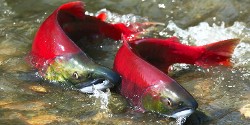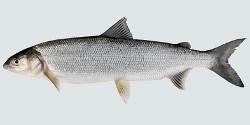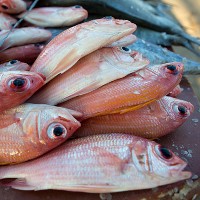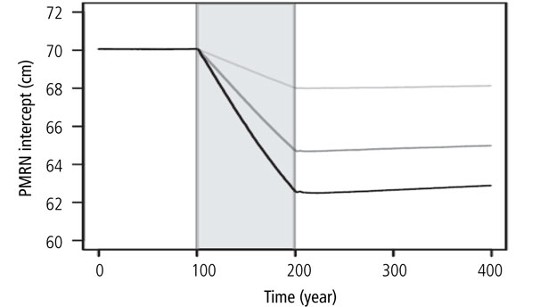Evolutionarily sustainable consumption
While aquatic food resources and fisheries-induced evolution are at the focus of this research, analogous challenges and solutions apply to any food-production system relying on self-renewing animal or plant populations:
- EEP continues to develop tools for tackling both fundamental and applied challenges related to exploitation-induced evolution. The resultant toolbox is reviewed in the forthcoming book edited by EEP scientists, Fisheries-Induced Evolution [1], and includes modeling tools for strategic and tactical evaluations (eco-genetic models and adaptive dynamics models [2] [3], as well as statistical tools for analyzing trends in exploited fish stocks [4]).
- Evolutionary Impact Assessment (EvoIA) is a new framework developed under EEP’s leadership by an international consortium of fishery experts. It offers an integrative platform for assessing the costs and benefits of management strategies to mitigate unwanted exploitation-induced evolution [5].
- A standard protocol for estimating fisheries-induced selection pressures is being developed in the international Working Group on Fisheries-Induced Evolution, co-chaired by EEP scientists. The working group operates under the auspices of the International Council for the Exploration of the Sea (ICES). The first results from this work were presented at the Annual Science Conference of The International Council for the Exploration of the Sea at A Coruña in September 2014 and received favorable attention from many scientists interested in applying these methods.
- The toolbox of methods developed by EEP continues to be utilized in many applications. The most recently published case studies have covered European whitefish in Austria [6] and sockeye salmon in Alaska [7].

Sockeye salmon; © Vasiko | Dreamstime

Whitefish; © Zhaubasar | Dreamstime
- Using the new EEP-developed standard protocol, fisheries-induced selection pressures have already been estimated for about 30 fish stocks, paving the way for a comprehensive comparative analysis.
- Eco-genetic models have been developed and calibrated for plaice in the North Sea [8] and for Atlantic salmon in Norway [9].
- Experimental approaches have demonstrated how behavioral traits can undergo fisheries-induced evolution [10]. The open questions arising in these experiments have been addressed in a recent review [11].
- Experimental releases of farmed salmon have been used to provide new estimates of the numbers of escaped farmed salmon [12].
- Bifurcation analysis was used to understand when fisheries may lead to disruptive selection [13], promoting diversification in exploited stocks.
- Eco-genetic models have been devised for understanding the practical implications for fisheries-induced evolution of differences between male and female fish [14] and for analyzing the impacts of fisheries-induced evolution on the recovery of fish stocks from overexploitation, accounting for the first time for fisheries-induced evolution in their genetic variability (Figure 1) [15].
Figure 1. Model-predicted evolutionary responses to exploitation. With the period of fishing being indicated by gray shading, the three curves show results for three different fishing pressures (increasing from top to bottom). The probabilistic maturation reaction norm (PMRN) intercept determines the body length at which fish mature. The pace of adaptation is much faster during exploitation than when exploitation is stopped, leading to very slow evolutionary recovery (click on image to enlarge).
- Further investigations have highlighted how variation in quantitative traits can be used for identifying fish stocks [16], how overlooked assumptions in growth models alter evolutionary predictions [17], and how within-season fishery dynamics affect ecological and economic outcomes [18].
References
[1] Dieckmann U, Godø OR & Heino M eds. Fisheries-induced Evolution. Cambridge University Press, UK, in preparation.
[2] Dunlop ES, Heino M, Dieckmann U. Eco-genetic models of fisheries-induced adaptive change. In Dieckmann U, Godø OR & Heino M eds. Fisheries-induced Evolution, Cambridge University Press, UK, in revision.
[3] Ernande B, Dieckmann U, Heino M. The adaptive dynamics of reaction norms. In Dieckmann U, Godø OR & Heino M eds. Fisheries-induced Evolution, Cambridge University Press, UK, in revision.
[4] Heino M, Baulier L, Boukal DS, Ernande B, Johnston FD, Mollet FM, Pardoe H, Therkildsen NO, Uusi-Heikkila S, Vainikka A, Arlinghaus R, Dankel DJ, Dunlop ES, Eikeset AM, Enberg K, Engelhard GH, Jorgensen C, Laugen AT, Matsumura S, Nussle S, Urbach D, Whitlock R, Rijnsdorp AD, Dieckmann U (2013). Can fisheries-induced evolution shift reference points for fisheries management? ICES Journal of Marine Science 70:707–721.
[5] Laugen AT, Engelhard GH, Whitlock R, Arlinghaus R, Dankel DJ, Dunlop ES, Eikeset AM, Enberg K, Jørgensen C, Matsumura S, Nusslé S, Urbach D, Baulier L, Boukal DS, Ernande B, Johnston FD, Mollet F, Pardoe H, Therkildsen NO, Uusi-Heikkilä S, Vainikka A, Heino M, Rijnsdorp AD, Dieckmann U (2014). Evolutionary impact assessment: Accounting for evolutionary consequences of fishing in an ecosystem approach to fisheries management. Fish and Fisheries 15:65–96.
[6] Ficker H, Mazzucco R, Gassner H, Wanzenböck J, Dieckmann U (2014). Fish length exclusively determines sexual maturation in the European whitefish Coregonus lavaretus species complex. Journal of Fish Biology 84:1164–1170.
[7] Kendall NW, Dieckmann U, Heino M, Punt AE, Quinn TP (2014). Evolution of age and length at maturation of Alaskan salmon under size-selective harvest. Evolutionary Applications 7:313–322.
[8] Mollet FM, Dieckmann U, Rijnsdorp AD. Reconstructing the effects of fishing on life history evolution in North Sea plaice (Pleuronectes platessa), in revision – a.
[9] Castellani M, Heino M, Gilbey J, Araki H, Svåsand T, Glover KA. IBSEM: An individual-based Atlantic salmon population model, in revision.
[10] Díaz Pauli B, Wiech M, Heino M, Utne-Palm AC (2015). Opposite selection on behavioural types by active and passive fishing gears in a simulated guppy fishery. Journal of Fish Biology, in press.
[11] Díaz Pauli B & Heino M (2014). What can selection experiments teach us about fisheries-induced evolution? Biological Journal of the Linnean Society 111:485–503.
[12] Skilbrei OT, Heino M & Svåsand T (2015). Using simulated escape events to assess the annual numbers and destinies of escaped farmed Atlantic salmon of different life stages from farm sites in Norway. ICES Journal of Marine Science 72:670–685.
[13] Landi P, Hui C & Dieckmann U (2015). Fisheries-induced disruptive selection. Journal of Theoretical Biology 365:204–216.
[14] Mollet FM, Enberg K, Boukal DS, Rijnsdorp AD & Dieckmann U. An evolutionary explanation of female-biased sexual size dimorphism in North Sea plaice (Pleuronectes platessa), in revision – b.
[15] Marty L, Dieckmann U & Ernande B (2015). Fisheries-induced neutral and adaptive evolution in exploited fish populations and consequences for their adaptive potential. Evolutionary Applications 8:47–63.
[16] Heino M (2014). Quantitative traits. In Cadrin SX, Kerr LA & Mariani S eds. Stock Identification Methods: Applications in Fishery Science, 2nd edition, Academic Press, Waltham, USA, pp. 59–76.
[17] Boukal DS, Dieckmann U, Enberg K, Heino M & Jørgensen C (2014). Life-history implications of the allometric scaling of growth. Journal of Theoretical Biology 359:99–207.
[18] Liu X & Heino M (2014). Overlooked biological and economic implications of within-season fishery dynamics. Canadian Journal of Fisheries and Aquatic Sciences 71:181–188.
Collaborators

CONTACT DETAILS
Principal Research Scholar Exploratory Modeling of Human-natural Systems Research Group - Advancing Systems Analysis Program
Principal Research Scholar Systemic Risk and Resilience Research Group - Advancing Systems Analysis Program
Principal Research Scholar Cooperation and Transformative Governance Research Group - Advancing Systems Analysis Program
Research program
Evolutionarily Sustainable Consumption



